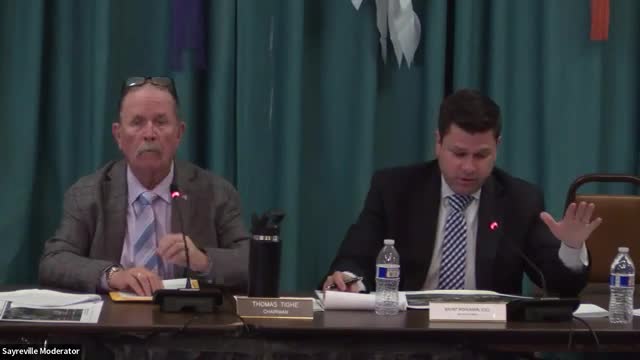Community Divided Over Controversial Religious Facility Expansion
October 16, 2024 | Sayreville, Middlesex County, New Jersey
This article was created by AI summarizing key points discussed. AI makes mistakes, so for full details and context, please refer to the video of the full meeting. Please report any errors so we can fix them. Report an error »

In a recent government meeting, significant discussions centered around a proposed religious facility's parking requirements and its potential impact on the surrounding community. The applicant's plan aims to accommodate 454 congregants, a figure that has raised questions among board members regarding its justification and the adequacy of parking spaces.
Concerns were voiced about the discrepancy between the applicant's testimony, which indicated a current congregation size of approximately 330, and the proposed capacity. Board members questioned the rationale behind planning for a nearly 50% increase in attendance without substantial data to support such growth. The discussion highlighted the need for a clearer understanding of the facility's usage patterns, particularly during peak service times, such as Friday prayers.
The applicant's representatives argued that the existing parking provisions, which include 166 spaces, are sufficient based on their traffic studies. However, board members expressed skepticism, particularly regarding the potential overflow of vehicles onto residential streets if the facility reaches its maximum occupancy. The board emphasized the importance of analyzing the implications of needing additional parking spaces and the potential burden on local traffic.
Public comments reflected a mix of support and concern, with residents questioning the adequacy of the proposed facility size and its impact on the neighborhood. Some residents called for a more comprehensive overview of the facility's intended use throughout the week, beyond just peak service times, to better understand the long-term implications for traffic and parking.
As the meeting progressed, it became clear that further clarification and additional data would be necessary to address the board's concerns adequately. The applicant has committed to providing updated plans and additional testimony to facilitate a more informed decision-making process in future meetings. The discussions underscore the ongoing challenges of balancing community needs with development proposals, particularly in areas experiencing growth and increased traffic.
Concerns were voiced about the discrepancy between the applicant's testimony, which indicated a current congregation size of approximately 330, and the proposed capacity. Board members questioned the rationale behind planning for a nearly 50% increase in attendance without substantial data to support such growth. The discussion highlighted the need for a clearer understanding of the facility's usage patterns, particularly during peak service times, such as Friday prayers.
The applicant's representatives argued that the existing parking provisions, which include 166 spaces, are sufficient based on their traffic studies. However, board members expressed skepticism, particularly regarding the potential overflow of vehicles onto residential streets if the facility reaches its maximum occupancy. The board emphasized the importance of analyzing the implications of needing additional parking spaces and the potential burden on local traffic.
Public comments reflected a mix of support and concern, with residents questioning the adequacy of the proposed facility size and its impact on the neighborhood. Some residents called for a more comprehensive overview of the facility's intended use throughout the week, beyond just peak service times, to better understand the long-term implications for traffic and parking.
As the meeting progressed, it became clear that further clarification and additional data would be necessary to address the board's concerns adequately. The applicant has committed to providing updated plans and additional testimony to facilitate a more informed decision-making process in future meetings. The discussions underscore the ongoing challenges of balancing community needs with development proposals, particularly in areas experiencing growth and increased traffic.
View full meeting
This article is based on a recent meeting—watch the full video and explore the complete transcript for deeper insights into the discussion.
View full meeting
